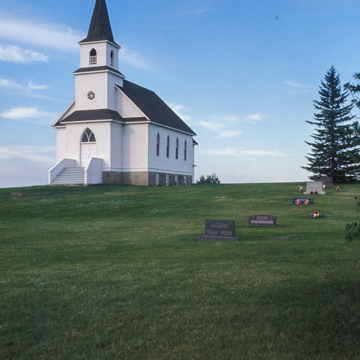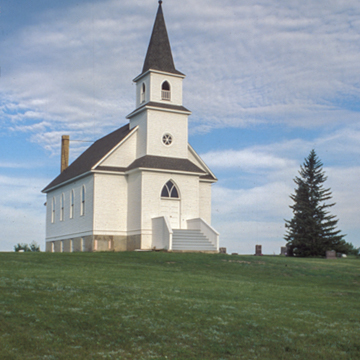This rural church, a replica of a church (1795) in Tynset, Norway, typifies a cultural resource rapidly vanishing from North Dakota’s prairie. Built by a rural immigrant community of Norwegian families, Tonset’s restrained Gothic Revival design was built by local woodworkers. Much like the establishment of homesteads on “unproven” land for agriculture, churches like Tonset reflect the community establishing itself spiritually. Standardized designs also were offered to immigrant congregations by the Norwegian Lutheran Synod based in Mankato, Minnesota. A century after many of these churches were built, communities in Sweden, Norway, and Denmark have shown interest in acquiring some of the vacated buildings for relocation to the “Old Country” as a way of celebrating cultural ties. As in many dwindling rural communities, it has become increasingly difficult to maintain a sufficient number of worshippers to keep an active congregation, but the buildings have become icons. The State Historical Society and the nonprofit organization Preservation North Dakota (PND) initiated several exhibits and publications to document these rural churches. With modest financial support from PND, successive generations of congregants from churches like Tonset have formed local preservation volunteer groups to maintain the church buildings and adjoining cemeteries.
You are here
Tonset Lutheran Church
1916. 89th Ave. NW, 0.2 miles south of 94th St. NW, approximately 4 miles southwest of Lignite
If SAH Archipedia has been useful to you, please consider supporting it.
SAH Archipedia tells the story of the United States through its buildings, landscapes, and cities. This freely available resource empowers the public with authoritative knowledge that deepens their understanding and appreciation of the built environment. But the Society of Architectural Historians, which created SAH Archipedia with University of Virginia Press, needs your support to maintain the high-caliber research, writing, photography, cartography, editing, design, and programming that make SAH Archipedia a trusted online resource available to all who value the history of place, heritage tourism, and learning.












